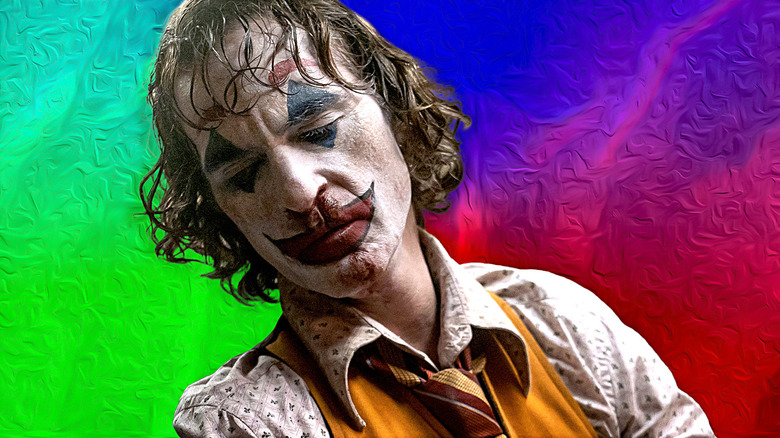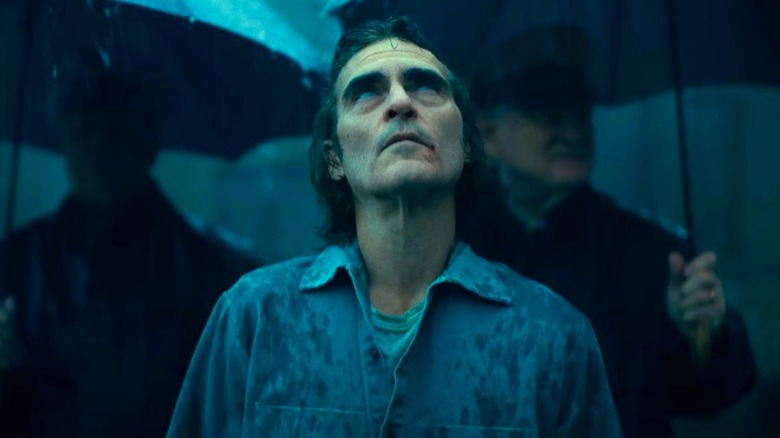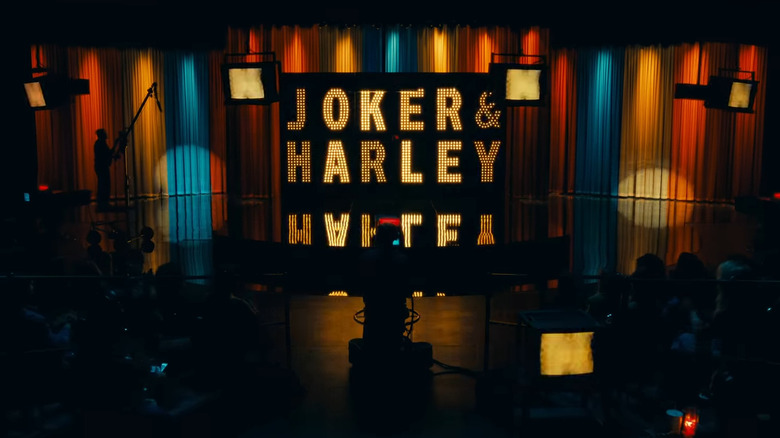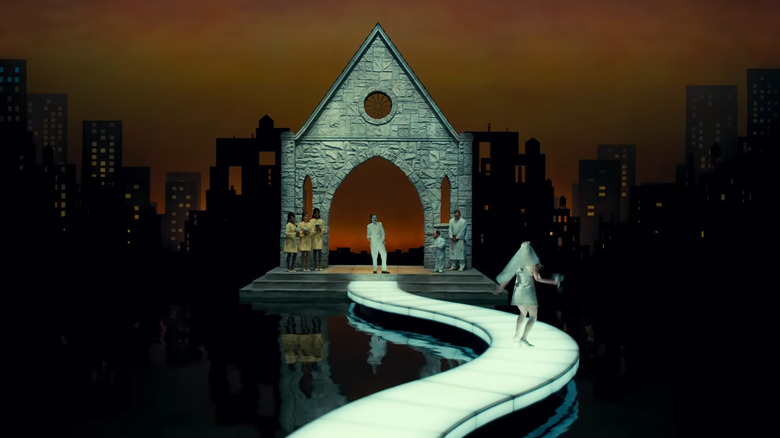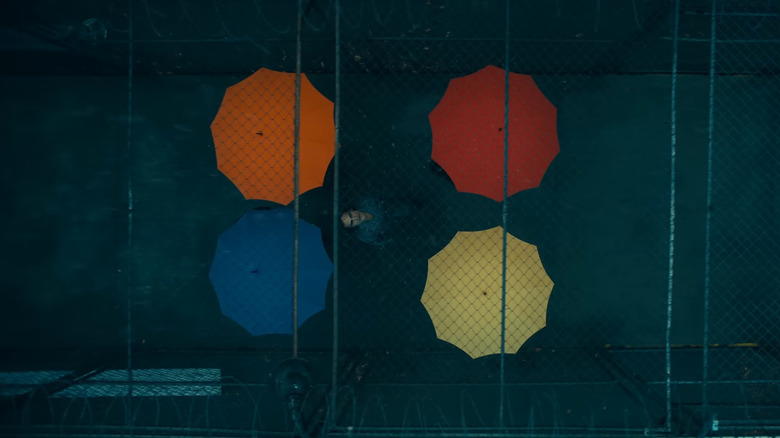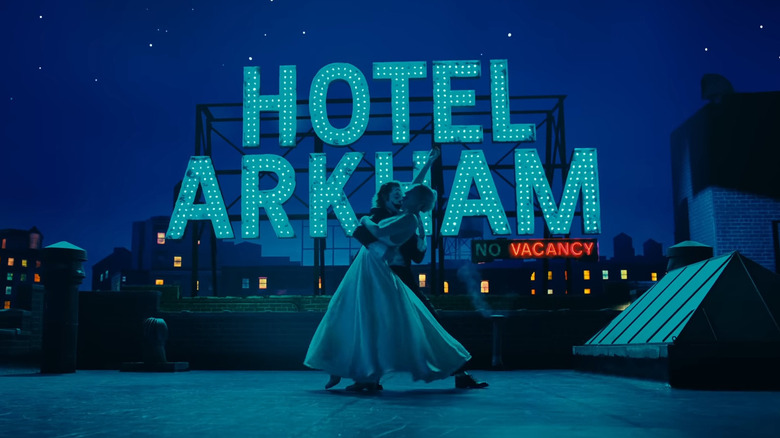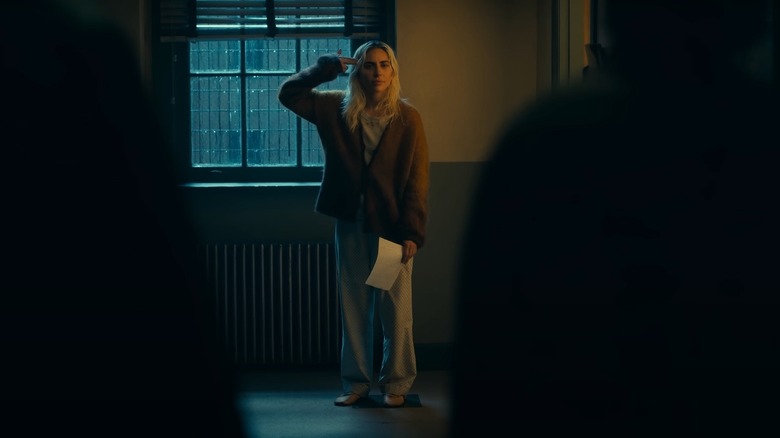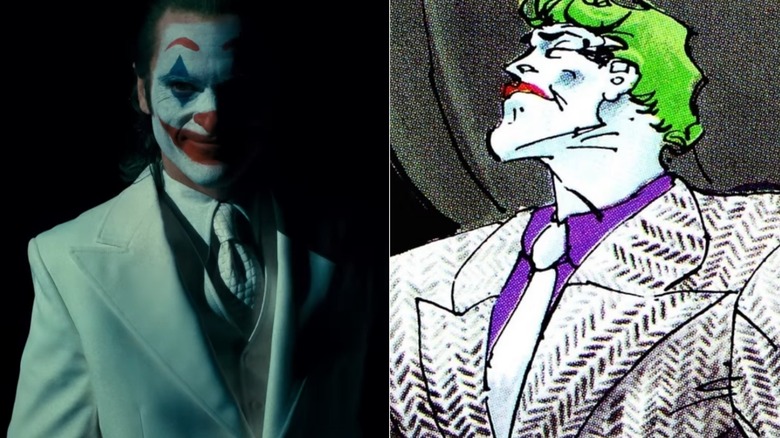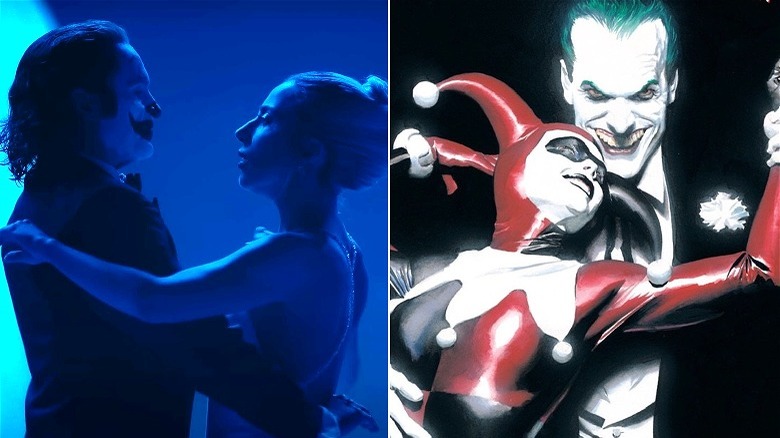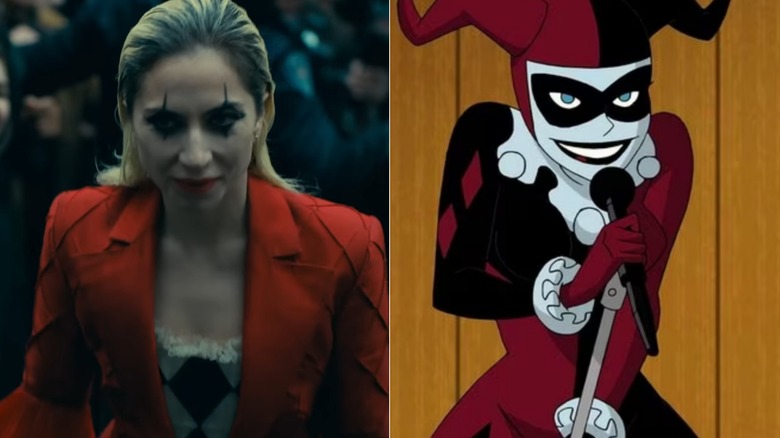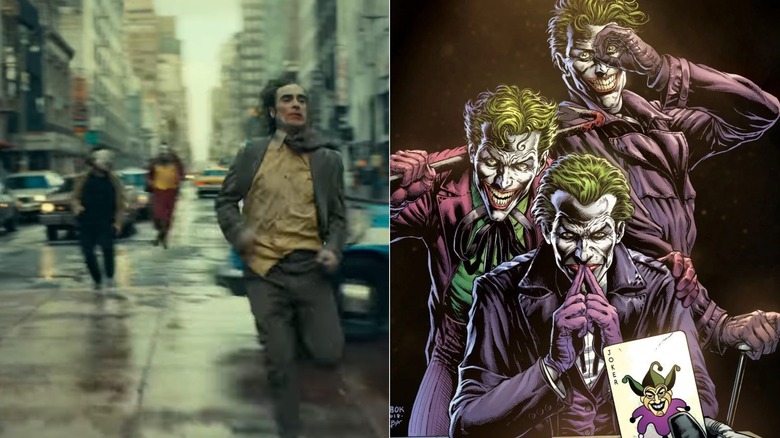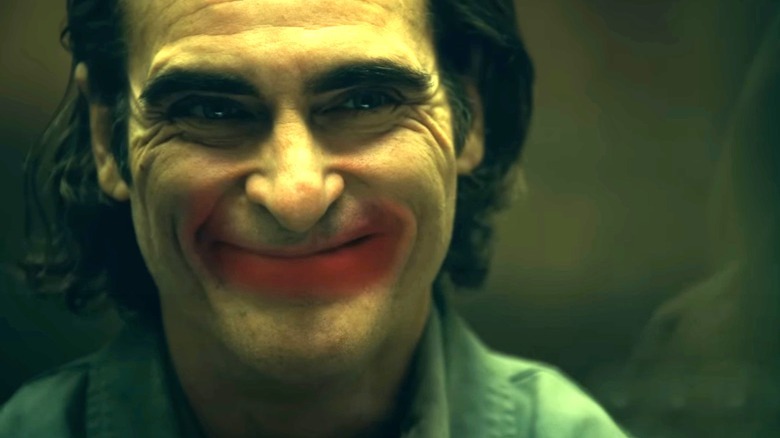The Joker: Folie à Deux Trailer Is Hiding So Many Details
We finally have our first look at "Joker: Folie à Deux," the dark and dreamy sequel to Todd Phillips' audacious 2019 comic book movie debut "Joker." Warner Bros. has released a teaser trailer, showcasing the sure-to-be destructive love affair between disillusioned comedian Arthur Fleck (Joaquin Phoenix) and fellow Arkham Asylum inmate Harley Quinn (Lady Gaga). As they dance in and out of the Joker's twisted, fractured psyche, one can only imagine what kind of chaos they will undoubtedly sow. However, we do get more than a few clues from this first trailer, including how the film's controversial genre twist will come into play.
If the original "Joker" failed to put a smile on your face, there's not much in this trailer to suggest that you'll be won over by its sequel. But if you did find yourself even slightly captivated by its arresting visual design, its references to the canon of classic cinema, or its connection to the rich history of the DC Universe, this trailer seems to promise everything you could hope for in a follow-up. And if you're worried that you might have missed something in the densely-packed teaser, don't worry — we've gone through it frame-by-frame to pick out the most striking and interesting moments.
The teaser hides that the film is a musical
It's become something of a trend for modern movie musicals to hide the fact that they are musicals at all during the early marketing process. Though one may be able to learn this information if they closely follow the trades, casual consumers can be caught off guard. So, if you didn't know this already, allow us to break the news to you: "Joker: Folie à Deux" is reportedly a full-blown musical set to classic pop standards. We feel like we need to tell you this, because the sequel's trailer certainly doesn't.
This peculiar marketing strategy isn't new for Warner Bros., which kept the fact that 2023's "Wonka" is a musical under wraps when promoting it. That same year, the studio released a new adaptation of Alice Walker's novel "The Color Purple." The trailer stated that it was based on the 1982 novel of the same name, but didn't mention that the film is actually a remake of the Broadway adaptation, only showing a few seconds of song. And this sneaky approach goes back even further than that.
In 2007, the studio released a highly-anticipated adaptation of the popular stage musical "Sweeney Todd: The Demon Barber of Fleet Street." Yet, despite the fact that every theater kid had been humming along to the richly grotesque score of the Stephen Sondheim masterpiece for years at that point, Warner Bros. perplexingly tried to market the film as a straightforward thriller. One can't help but wonder why Warner Bros. keeps making musicals if it doesn't even have the confidence to market them as such.
There's a callback to Robert De Niro's Murray Franklin
Though Arthur Fleck may be looking for a fresh start with what will likely be described as a "mad love" (the name of a one-shot comic written by Paul Dini and Bruce Timm) with Lady Gaga's Harley Quinn, it seems like the ghosts from his past will be coming back to dance with him once more. And in some cases, we mean "dance" quite literally.
At around the halfway point of the teaser trailer, Arthur and Harley are seen dancing on a television set. As they groove to the music of a live band (with Harley seemingly on the keys, almost certainly courtesy of Gaga's real-life instrumental prowess), large box lights and an "APPLAUSE" sign hang above their heads. Based on the instantly recognizable orange, yellow, and turquoise color scheme of the curtains behind the pair, there's a strong possibility that this set was inspired (either in reality or in one of Arthur's hallucinations) by the set of his old nemesis, Murray Franklin (Robert De Niro).
As readers may remember, Murray was a famous comedian and talk show host, as well as Arthur's personal hero-turned-torturer after he mocked one of Arthur's jokes in front of his national television audience. He was ultimately murdered by the newly-christened Joker during an interview on his show. This new "set" could represent Joker taking ownership of a humiliating and potentially traumatizing chapter in his life through his relationship with Harley.
Elaborate sets evoke old Hollywood dance scenes
Say what you want about Todd Phillips' original "Joker" film, you have to give it some credit for displaying some of the most deliciously moody sets ever seen in a comic book film. "Joker: Folie à Deux" appears to be upping the ante, with elaborate, scenic design that melds the dour world of Arthur Fleck with the synthetic glamor of old Hollywood movie musicals. In some shots seen in the teaser trailer, Arthur and Harley literally appear to be on a stage with a flat, painted background.
One set in particular — which appears to be the chapel where Arthur and Harley will presumably be "wed" — calls to mind the sort of sets seen in Michael Curtiz's 1954 film "White Christmas." The film (which follows two World War II veterans trying to revive a wintery resort run by their old general) features many jaw-dropping dance numbers, including one set to Irving Berlin's "Mandy." The titular character in the song is an independent young woman who nevertheless is urged to get married as soon as possible in the lyrics.
This could be Phillips drawing a comparison between the outdated and gendered expectations of many older musicals ("White Christmas" most certainly included) and the plight Harley finds herself in once she becomes the object of Arthur's obsessions. Or it might be totally disconnected, and we simply watched too much TCM during quarantine. Who's to say?
Singin' in the Rain
Given that the teaser trailer features little in the way of singing, it seems that "Joker: Folie à Deux" will follow in the footsteps of "Wonka" and the recent remake of "Mean Girls" by marketing itself as a straightforward movie. But, even if we don't get any clips of Gaga or Phoenix crooning tunes in this trailer, there are plenty of musical references to get those in-the-know excited.
Arguably the clearest direct reference to another movie musical comes early in the trailer, when it seemingly introduces us to how Arthur will hallucinate through song-and-dance throughout the film. While walking with four guards (presumably in the courtyard of Arkham Asylum), their dark-colored umbrellas suddenly turn technicolor. The aerial shot bears a strong resemblance to imagery from Gene Kelly's 1952 classic "Singin' in the Rain."
This visual Easter egg may be just that and nothing more. However, as it's an apparent nod to a film about the motion picture industry going through a tremendous, romantic, and yet often tumultuous transition, perhaps a parallel is meant to be drawn between that journey and the one Arthur is on the cusp of experiencing with Gaga's Harley. It's also likely no accident that "Singin' in the Rain" is one of the most famous musicals ever, which makes its presence within the darkly "comic" world of the Joker all the more eerie.
Hotel Arkham
2019's "Joker" wasn't just an origin story for one of pop culture's greatest villains, it was also a depiction of one man's struggle with mental illness and how the world left him behind. We know from the first movie that the way Arthur Fleck sees the world is often not the way it really is, and "Joker: Folie à Deux" takes that one step further. It's assumed that the psychiatric ward that Fleck is being held in is this world's version of DC's infamous Arkham Asylum, and that fact is hammered home in the teaser trailer's only musical sequence, set on a rooftop.
As Harley and Joker dance, we see an illuminated sign which confirms that the sequel includes the well-known location from the DC Universe. But instead of "Arkham Asylum," the sign reads "Hotel Arkham," demonstrating that Fleck's perception of his surroundings is not the reality. The way he sees it (at least in this moment), he and Harley are not patients in a hospital at all — instead, they appear as performers in a theatrical musical, as the scene has all the trappings of a stage production. The rooftop, the sign, and even the city skyline behind them all appear to be part of a set rather than a real-life location, but make no mistake: This is Arkham Asylum, not a romantic hotel.
A dark callback to Sophie
There are several moments in the "Joker: Folie à Deux" teaser trailer that feel like callbacks to the previous film. This includes the moment where Lady Gaga's Harley Quinn puts on her makeup and pokes at her face as if examining who she really is while staring into a mirror. There's another moment in the trailer that appears to be a dark reprise of an important scene from the first film, one involving an entirely different character. This snippet from the teaser perhaps offers some clues about what's really going on in the sequel.
In "Joker," Arthur Fleck interacts with a woman named Sophie Dumond (Zazie Beetz), a single mother who lives in his apartment building. When they first meet, Sophie's kid is acting up. She makes a hand gesture mimicking a gun to her head, jokingly implying that she's fed up with her daughter's behavior. Arthur then repeats the gesture. The two appear to grow close afterward, but the rug is pulled out from under the audience when it's revealed that his blossoming relationship with Sophie is entirely imagined, a product of Arthur's delusions. In the teaser for "Folie à Deux," we see Lady Gaga — before her full transformation into Harley Quinn — making the same gesture, presumably to Arthur. This is seemingly a nod to their relationship being partly a fantasy, as the musical scenes seem to imply.
Joker's white suit looks familiar
One of the biggest nods that the "Joker: Folie à Deux" trailer makes to greater DC Comics lore comes from the title character's wardrobe. Though Joker is usually known for his trademark purple suit, sometimes the Clown Prince of Crime dons another color. In the Frank Miller classic "Batman: The Dark Knight Returns," the Joker comes back after years of being in a catatonic state to battle Batman to the death. In fact, the now-iconic moment in the 2019 film when Arthur Fleck is on live television with Murray Franklin is eerily reminiscent of the Joker's TV appearance in Miller's original comic book, right down to his brutal murder of his gracious host on camera.
In the teaser trailer for "Folie à Deux," we see the Joker proudly sporting a white suit that will no doubt remind fans of the one he wore in "The Dark Knight Returns," both in the original comic book and its two-part animated adaptation. Previously, Zack Snyder snuck plenty of nods to this story into "Batman v Superman: Dawn of Justice," and Snyder still hopes to one day adapt "The Dark Knight Returns" properly for the screen. Likewise, Phillips has clearly been influenced by Miller's graphic novel. Given that both the original comic and Phillips' "Joker" films exist under DC's "Elseworlds" brand, it isn't surprising that the film would lean heavily into this material for inspiration.
A nod to a classic cover
Comic book movies love to pay homage to classic imagery from the source material, and the first teaser for "Joker: Folie à Deux" does exactly that more than once. As a rendition of the 1965 song "What the World Needs Now Is Love" swells, we see Joker and Harley Quinn dancing on a rooftop. While the Joker's aforementioned white suit will no doubt conjure up the character's similar appearance in Frank Miller's "Batman: The Dark Knight Returns," Joker and Harley's embrace harkens back to another, more specific image.
First used as the cover for the one-shot comic "Batman: Harley Quinn" in 1999, the image of Harley dancing with the Joker became an iconic one. That original painting by Alex Ross — based on a reference photo of the artist himself — showed Joker decked out in a black tuxedo and holding Harley in his arms. He has one hand wrapped around her body as she looks up at his grinning face in awe. Though the specifics in the trailer are somewhat different, this image by Ross has become so well-known that the scene feels like a tribute of sorts to the classic cover.
Harley's wardrobe is a clear reference to her original look
In comic book movies, costuming can be everything. For a long time, modern superhero films shied away from pulling directly from the spandex-inspired uniforms of many comic book heroes, trading them in for fashionable leather and other form-fitting material that felt more akin to the times. But in the explosive age of superhero films that we enjoy presently, the days of being ashamed of classic outfits are long gone. The Joker himself may have some pretty straightforward attire, but, traditionally, Harley Quinn dresses a bit more like a clown. While Lady Gaga's Harley Quinn is taking a more modern approach, her wardrobe is still a clear callback to her initial on-screen costume.
First appearing in "Batman: The Animated Series," Harley Quinn wore an outfit more akin to a court jester than a supervillain. Yet, Harley made an immediate splash and it wasn't long before she was welcomed into official DC canon. With a memorable red and black outfit paired with white makeup, Harley was always ready to play with her Mr. J whenever he broke out of Arkham. While Harley has moved away from her original masked outfit in recent years, even her current costumes often recall the original. From what we can see in the "Joker: Folie à Deux" teaser trailer, Gaga's version also pays tribute.
Multiple Jokers might have multiple meanings
In the first "Joker" film, Arthur Fleck incited what almost amounted to a revolution as the people of Gotham rose up against the wealthy elites, inspired by the Clown Prince of Crime's particular brand of ethics. While it's no secret that the Joker isn't exactly role model material, that clearly hasn't stopped other Gotham citizens from donning face paint and clown attire to prance about the city alongside their new idol. In fact, from what we see in the "Folie à Deux" teaser, Arthur is followed around town by other Jokers. While this might not be a direct reference to any specific comic book, fans should note that in the DC Universe, there isn't just one Joker: there are three.
In Geoff Johns' groundbreaking "Batman: Three Jokers," the Dark Knight discovers that three different individuals have been the Joker the entire time. Known as the Clown, the Criminal, and the Comedian, each of these Jokers represents a different era in comic book history, and each has his own unique tie to the Caped Crusader. Arthur Fleck most closely resembles the Comedian, but that doesn't mean the Clown and the Criminal couldn't show up at some point down the line. Of course, that's not the only way the idea of multiple Jokers could come into play: In the animated series "Batman Beyond," a street gang inspired by Batman's archnemesis called the Jokerz is often seen terrorizing Gotham.
Let's put a smile on that face
It shouldn't surprise audiences that the trailer for the next "Joker" movie ends with a smile. After Harley draws a smile on some glass using her red lipstick, Arthur positions himself so it looks like he's wearing the curved red line as makeup. He then gives an eerie smile as the "Joker: Folie à Deux" title pops in: Now that's how you end a trailer. While we don't know why Arthur is behind the glass or what this moment means for the character within the overall context of the film, we can deduce that it's a pivotal turning point for Joaquin Phoenix's Joker as he continues to define himself as Gotham City's notorious Clown Prince of Crime. As Heath Ledger's Joker once said, "Let's put a smile on that face!"
While this closing shot may not be a reference to anything in particular, we can't help but see the parallels between this and a certain deleted scene from Matt Reeves' "The Batman," which is also getting a sequel. Robert Pattinson's Batman encounters Barry Keoghan's Joker at Arkham Asylum, where the villain sits behind reinforced glass. You can't make out much of Keoghan's Joker — he's purposely blurred, with Reeves clearly intending to keep his version of the character a mystery — but there's an apparent smile-like scar that runs across his face, much like Ledger's version. This final moment from the "Folie à Deux" teaser might be nothing more than a cool shot, but it could also be a small nod to the other on-screen Jokers.
